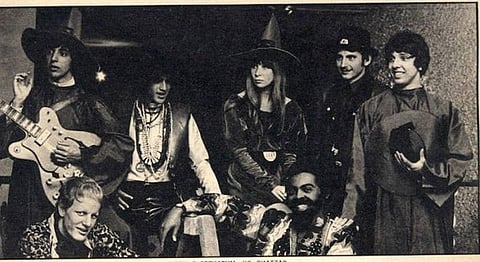
- HOMEGROWN WORLD
- #HGCREATORS
- #HGEXPLORE
- #HGVOICES
- #HGSHOP
- CAREERS
- ABOUT US
- CONTACT US

Social unrest was rampant in 1960s Brazil as the military government stifled any form of protest to their suppression of the nation’s culture. It’s no surprise then that this period of confrontation and oppression gave birth to an anti-establishment and subversive artistic revolution in the late 1960s, founded by a group of young critical thinkers, known as Tropicália, Tropicalismo, or Tropicalism abroad.
Encompassing different forms of art—from music and poetry, to theatre and visual arts—Tropicalism was a change in aesthetics, a ‘cultural cannibalism’ as Caetano Veloso called it, known as antropofagia which was held as a central characteristic of the movement, originally an idea put forth by poet Oswald de Andrade in his Manifesto Antropófago, published in 1928. This form of cannibalism was encouraged—to devour different cultural and musical influences and create kind of hybrid culture of their own with the Brazilian folk music, American rock, the psychedelic and the avant-garde and use this new fusion of the regional and international in their art, they saw it “as a resistance to cultural colonialism rather than a perversion of traditional Brazilian culture,” writes Sandy Anger.
Today, when we think of Tropicalism, we instantly associate it with the huge change that took place in the music scene of the time. Both Gilberto Gil and Caetano Veloso—the two who headed the Tropicalists, along with Gilberto Gil, Os Mutantes, Gal Costa, Nara Leao and Tom Ze, all of whom were part of the famous 1968 album Tropicália: ou Panis et Circencis which is often referred to as the musical manifesto of the Tropicalists— were children of Bossa Nova, the popular musical style of the age of innovative beats and rhythms. Gil and Veloso merged the traditional and globally popularised Bossa Nova style with new-age rock and roll. Inspired by the hippie culture of the US, Tropicalists sported ‘untraditional’ clothing and long hair, inserted anti-establishment slogans in their songs which shocked the audience opposed to international influences on their beloved local traditions, as much as it stirred a change and new thought. “One of the greatest conquests of Tropicalism was undoubtedly to have been able to stand up to—despite the hostile circumstance—the military regime. It managed to carry on this action as far as it was possible to,” said Gil in a documentary.
“Tropicalism was widely inspired from the street carnival of Bahia. This movement, which was meant to be a radical one, was courageous enough to believe in the power of Brazilian music. At the same time it refused it to convey any defensive nationalism, as it was the case during the last years of Bossa Nova. Our movement was a big scandal here in Brazil,” stated Veloso. “It mixed different kinds of styles which frightened and scandalised people...It was a typical movement of the 60s, with a ‘flavour’ of counter-culture and pop art.”
The day of Tropicalism’s birth is pointed to a performance by Veloso and Gil at the Festival de Música Popular da TV Record in São Paulo. Having broken away from the traditional musical style and lyrics of the time, the audience booed them off stage, many even citing their act as anti-national behaviour. It was after this performance that the movement was officially named Tropicalismo, with Veloso’s song Tropicalia which took its name from visual artist Hélio Oiticica’s installation. As Christopher Dunn writes in ‘The Tropicalista Rebellion,’ “Tropicalismo had in common with American Pop Art its technique of taking a culturally repulsive, quotidian object, dislocating it from its context and allowing people to see it in a new or beautiful light.” Further commenting on Carmen Miranda’s positioning as a pioneer of the movement: “Veloso compares the appearance of Carmen Miranda at the end of his song to Andy Warhol’s painting of the Campbell’s can of soup. To Brazilians, Miranda represented the unequal American/Brazilian cultural exchange in which anything Brazilian was ‘vulgarised and stereotyped.’ Veloso’s mention of Miranda was an ‘affectionate, ironic wink at a cultural icon who had transformed into a symbol of Brazilian kitsch following her debut in the United States.”
Tropicalism wasn’t just viewed as an upheaval of art and aesthetics in Brazil but as a socio-political movement as well with the address of many issues afflicting Brazil’s citizens, from poverty and ‘cultural terrorism’ to problems of the middle class and criticising the untouched bourgeois. “Music was a medium of communication used to critique the regression to military authoritarianism in Brazil; Tropicalismo was not intended to be an anti-national movement, but a rejection of ‘prescriptive formulas for producing authentic national culture. Caetano calls this an ‘aggressive nationalism’ in which they assimilated advances in foreign pop music without sacrificing originality and authenticity,” writes Dunn.
As Dunn points out, the music of Tropicalism was upbeat and rhythmic but they often carried strong undertones of political criticism. But as the different styles merged, the reaction from the Marxist-left faction of society who strongly rejected Tropicalism which they viewed as being more and more influenced by foreign capitalist culture, especially that of the United States, which ‘corrupted’ their Brazilian tradition.
From the poetry of Torquato Neto and Jose Celso Martinez’s theatre to experimental films, androgynous fashion and vivid paintings–Tropicalism seeped into everything, and though its early demise with the arrest and exile of Veloso and Gil in 1969 by the military government after a performance in Rio where an image of a favela bandit being shot by police with the provocative slogan ‘Seja marginal, seja heroi! (be a criminal, be a hero),’ the gap between Brazilian culture and universal pop-culture had slowly been bridged. The counter-culture movement has been observed as the South American version of the hippie movement inspired by the Beatles that took over in the 60s. Though it didn’t last long, its affects on Brazilian art and culture still exist as they redefined and refashion their country’s image to the world as well as embrace its own multiculturalism.
